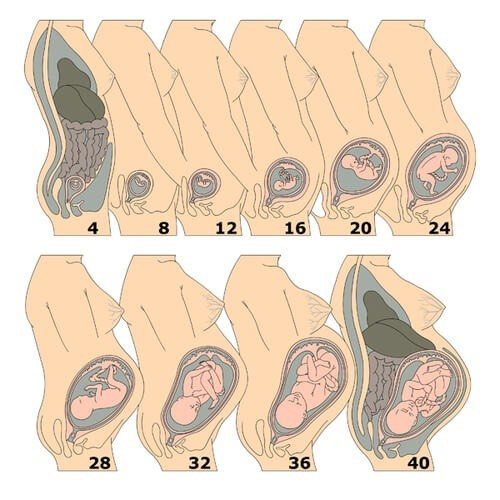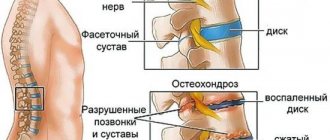Why does the sciatic nerve get pinched in pregnant women?
Not all pregnant women develop sciatic nerve entrapment. Women who have previously had any changes in the musculoskeletal system are predisposed to this.
They may exhibit the following conditions:
- degenerative-dystrophic changes in the spine (in the vertebrae themselves, intervertebral discs, ligaments);
- developmental anomalies of the musculoskeletal system;
- pathology of the joints of the lower extremities, asymmetry of leg movements when walking;
- postural disorders, smoothing of lumbar lordosis, the presence of curvature of the spinal column;
- history of injuries or surgeries on the spine or pelvic bones;
- weakness of the muscular frame, which leads to insufficient support of the spinal column.
But even if a woman previously had no prerequisites for the development of spinal diseases, during pregnancy she may also suffer from back pain and pinched sciatic nerve. The reason for this is a change in the elasticity of the ligaments under the influence of hormones and a violation of the configuration of the spine during long periods of gestation.
With a significant increase in the abdomen, the lumbar lordosis (the natural forward curve of the spine) is smoothed, the center of gravity shifts and the pelvic bones move apart due to the pubic and iliosacral joints. As a result, the tension of the ligaments and muscles changes, creating conditions for the narrowing of natural openings. The enlarged uterus puts pressure on surrounding organs and the sacral plexus on the inner surface of the pelvis.
The sciatic nerve is the longest and thickest nerve in the human body. It is formed from several roots of the spinal nerves - 4 and 5 lumbar and 1-3 sacral roots. They form the sacral plexus, from which the sciatic nerve is formed on each side. It can be pinched in 2 places - in the area of the roots and when exiting through the space under the piriformis muscle.
Therefore, pinching and subsequent inflammation of the nerve can result from compression or stretching of any of the roots, compression of the sacral plexus, as well as spasm of the piriformis muscle in the lumen of the greater sciatic foramen of the pelvis (this is called piriformis syndrome). All this can occur during pregnancy.
The sciatic nerve passes through all the areas that are most vulnerable during pregnancy - the sacrum, buttocks, back of the thigh and legs to the foot. If it is pinched, neuralgia (sciatica) is diagnosed.
In the early stages, back pain often occurs after exercise, but quickly subsides. Such symptoms do not refer to the manifestation of inflammation of the sciatic nerve - these are normal manifestations that occur against the background of hormonal changes in the body.
The main causes of nerve inflammation:
- pressure of the uterus on the sacrum - this is where the nerve exits the spine;
- excess weight, high water intake, bearing several fetuses - under pressure, worn-out discs shift, pinching nerve endings;
- exacerbation of chronic diseases - diabetes mellitus, infectious diseases of the pelvic organs, spinal injuries;
- various types of tumors;
- metabolic disorders, blood clots.
In the first trimester of pregnancy, the causes of sciatica are the same as in other people. These include:
- chronic diseases of the spine (osteochondrosis, herniated discs, disc displacement);
- injuries or surgeries of the lumbar vertebrae;
- violation of safety regulations when playing sports;
- obesity;
- sedentary lifestyle;
- poor posture (scoliosis);
- severe hypothermia.
One of the causes of a pinched nerve is a herniated disc.
In the second and third trimester, a pinched sciatic nerve can occur even in healthy women. This is directly related to the increase in the volume of the uterus several times: the organ moves posteriorly and puts strong pressure on the area of the sacral plexus. The development of sciatica is also facilitated by extremely active movements of the fetus in the womb.

An enlarged uterus causes compression of nerve trunks
How to treat
In most cases, sciatica treatment is carried out at home. But if a woman experiences severe pain and has difficulty moving without assistance, doctors insist on hospitalization. The main goal of treatment is to reduce the severity of pain: this is achieved with the help of medications, compresses, massage and a course of physiotherapy.
To improve the general condition, a woman is recommended to be exposed to stress as little as possible and follow a diet with minor restrictions. The prognosis for pinched sciatic nerve is favorable: after treatment, remission occurs within two weeks. Less common are cases of the disease becoming chronic with periodic exacerbations.
During pregnancy, most medications cannot be taken. After all, they pass through the placenta to the fetus, causing various disorders in it and posing a threat to its further development. Therefore, the question arises of what to do if a pinched sciatic nerve develops during pregnancy. Most often, it is possible to alleviate a woman’s condition with the help of non-drug measures and local therapy.
These include:
- use of ointments, compresses, rubbing;
- correction of position during sleep.

But you should not self-medicate. The appearance of pain in the lower back, sacrum and buttocks may be a sign of obstetric pathology, which only a doctor can exclude. To select adequate therapy, you may need to consult a neurologist, vertebrologist, or chiropractor.
For pain relief, it is permissible to use agents with a local distracting and anti-inflammatory effect. Even if the pain is mainly felt in the leg, ointments should be applied to the lower back, sacrum and buttock, that is, places where the sciatic nerve may be pinched.
On the recommendation of a doctor you can use:
- products based on bee venom,
- semi-alcohol or water compresses,
For severe pain, a neurologist may prescribe short-term use of ointments and gels with non-steroidal anti-inflammatory drugs. Typically, their active ingredient is diclofenac. It should be remembered that even these local agents can enter the systemic circulation, albeit in small quantities. Therefore, you should not exceed the recommended dose and duration of use.
You can reduce pain and relieve muscle spasms using massage and manual therapy. Such treatment should only be carried out by a specialist with experience working with pregnant women, because these manipulations should not lead to an increase in the tone of the uterus.

An important point in treatment and prevention is to reduce the load on the lumbosacral spine and carry out special exercises when the sciatic nerve is pinched during pregnancy. It is recommended to wear bandages, sleep on a semi-rigid mattress with a pillow or bolster placed between the thighs, and gradually get out of bed (with rolling over and over the side).
A pinched sciatic nerve during pregnancy can cause a woman a lot of suffering. You should not be afraid to treat this condition; properly selected complex therapy will reduce pain and alleviate the condition.
Basic measures to prevent sciatica during pregnancy
Pinched sciatic nerve is one of those diseases that can be prevented in advance. If you do not want to jeopardize your health and your unborn child, you need to adhere to the following recommendations:
- eat right: this will help you avoid gaining extra pounds, which increases the risk of developing sciatica;
- wear a special bandage for pregnant women: it helps to evenly distribute the load;
- Walk more, do light exercises and lead an active lifestyle;
- watch your posture: curvature of the spine is one of the causes of pinching of the sciatic nerve;
- always dress appropriately for the weather: this will avoid hypothermia;
- treat chronic spinal diseases before planning pregnancy.
Even with a full course of therapy, sciatic nerve pinching may return during the next pregnancy. To avoid this, doctors recommend following the rules of prevention and carefully monitoring your condition. Taking good care of your health will help keep negative consequences to a minimum.
When the sciatic nerve is pinched during pregnancy, a woman experiences unbearable pain. According to statistics, pathology occurs after the 16th week of gestation in 90% of cases. This condition poses a threat to mother and baby. Therefore, you need to know what a pinched sciatic nerve is during pregnancy, symptoms and treatment.

How to recognize the disease?
Inflammation of the sciatic nerve during pregnancy often occurs acutely, sometimes a woman can neither sit nor stand, but sometimes the symptoms can be somewhat blurred, then the woman cannot make only complex movements.
At first, a woman may confuse the pain that begins in the lumbar region with a normal load on the back; the pain is not significant.
But after a certain period of time, the pain will seem to shoot in the leg, sometimes in both, along the back surface reaching the fingertips. Sometimes only the hip may hurt, and the rest of the limb becomes numb.
In addition to pain, a woman may notice the following signs:
- numbness of the gluteal region, feet;
- the surface of the thigh is hot to the touch;
- increase in general body temperature;
- weakness of the muscles of the lower body;
- bloody issues.
Frequent urination, which accompanies late pregnancy, may give way to impaired urinary excretion or incontinence. A woman may suffer from constipation followed by diarrhea.
Yoga for the well-being of expectant mothers

Yoga is not contraindicated in any trimester. However, if the sciatic nerve is affected during late pregnancy, the pain is sharp, you should first consult a specialist.
If the sciatic nerve is affected, treatment during pregnancy may include the following yoga movement:
- To squat.
- Rise on your toes, arms in front of you.
- Sit like this for 10 minutes.
This must be done with caution so as not to accidentally fall and harm yourself and the child.
During pregnancy, pinching of the sciatic nerve, what to do from yoga movements:
- Place your palms and knees on the floor.
- As you inhale, bend your back upward without leaving the supporting surface.
- As you exhale, return to the original position.
Pinched sciatic nerve, how to treat during pregnancy with yoga:
- Sit in the lotus position, clasp your palms together.
- Smoothly raise your hands.
- Stay in this position for 15–20 minutes.
Breathing should be measured.
Aquagymnastics is indicated for all women in delicate situations, and not only when the nerve ending is damaged. She helps:
- reduce the load;
- relieve pain;
- improve emotional state;
- prepare for labor.
There are specialized centers where you can attend classes with an instructor. He knows how to treat the sciatic nerve during pregnancy using aqua gymnastics.
In the first trimester, the following exercise will help you cope with painful sensations:
- Place your foot in front of you on a low stool.
- Make a slow tilt of the body towards the limb.
- Stay for a minute.
The back should be straight, breathing should be measured.
Symptoms and treatment of pinched sciatic nerve in pregnant women have been discussed. It is also important to know what the disease is fraught with.
Unconventional methods of treatment
Pregnant women are prohibited from taking any medications, so exercise and massage will help relieve pain. The best way to relieve pain due to inflammation of the sciatic nerve during pregnancy is manual therapy.
Treatment of the sciatic nerve during pregnancy is challenging. Its peculiarity is that medications have an adverse effect on the development of the fetus, therefore an individual approach is important when choosing a method of therapy. Only a doctor prescribes medications, physical therapy or alternative methods to a woman.

What should you do if you experience severe pain in the sacrum and lower back during pregnancy? A neurologist or osteopath can prescribe adequate treatment for inflammation of the sciatic nerve. Any self-medication can harm the baby’s health.
Many anti-inflammatory and pain medications are prohibited during pregnancy, but this does not mean that a pregnant woman should simply endure the pain.
How to treat pinching during pregnancy:
- anesthetic blockades - injections are used to eliminate severe pain symptoms;
- massage – allows you to restore the correct position of the vertebrae, it can only be performed by a specialist;
- pain-relieving suppositories – Diclofenac;
- ointments and other painkillers for external use - Menovazin, Voltaren;
- chondroprotectors that restore cartilage tissue cells - Teraflex M, Chondroxide;
- vitamin preparations for relaxing muscles and improving blood circulation based on vitamin E, group B.
Therapeutic exercise is the best and safest way to eliminate pinched sciatic nerve. But only a doctor should develop the complex, based on the duration of pregnancy and individual indicators.
A set of exercises to eliminate pain in the lumbar region:
- Take a knee-elbow position, bend your back as much as possible, pull your sacrum up, lower your head. Remain in this position for 5–7 seconds, rounding your back.
- Arch your pelvis while standing. Spread your legs wide apart, bend slightly, arms extended forward for balance. Bend, push your lower back forward, and after 5 seconds return to the starting position.
- Place a chair, lean on it with one leg, straighten your back. Slowly lean towards the chair - you need to feel how the muscles of the back of the thigh stretch. At the extreme point, hold for 5 seconds and return to the starting position. Do 10 approaches on each leg.
- Lie on your back, arms and legs straight, relax. Move forward only with the help of your shoulder blades as much as possible.
A contrast shower will help get rid of pain - you need to pour warm and cool water on your lower back alternately. But you need to remember that very hot and ice water is contraindicated for pregnant women.

Sciatica can be treated during pregnancy using folk remedies - rubbing or herbal baths.
Compresses
For warming compresses, you can use beeswax, which must first be heated to a plastic state. You need to make an applique out of it on the lower back, secure it on top with cling film and a down scarf. With this compress you can sleep all night.
You can prepare a solution for compresses from chamomile and elderberry. Mix 20 g of herbs, pour 300 ml of boiling water. After half a minute, wrap the herbs in a natural thin cloth and tie a warm scarf to your lower back for 4–6 hours.
Diagnosis of pregnant women with sciatica

If the sciatic nerve is pinched during pregnancy, most instrumental diagnostic methods are unacceptable, as they can harm the baby. The diagnosis is made according to the following scheme:
- A gynecologist or therapist gives a referral to a neurologist to determine why the sciatic nerve hurts during pregnancy.
- The specialist prescribes tests.
- Writes out a referral for an ultrasound scan.
- Performs motor tests.
- Individually prescribes electroneuromyography.











